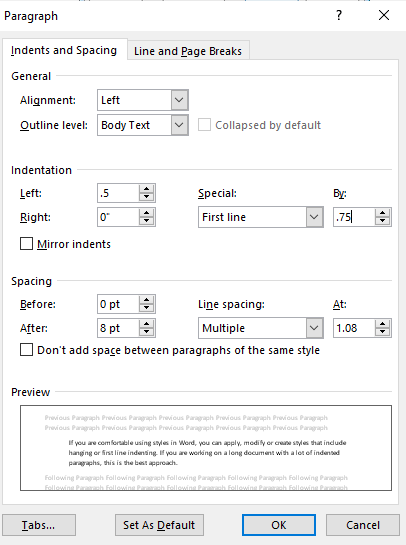
- #How to do a hanging indent on word 2010 how to
- #How to do a hanging indent on word 2010 mac os
- #How to do a hanging indent on word 2010 series
These are the steps for using indent in Word. To apply this sort of indent to the whole document you need to select all again and repeat the process. Undo the changes once again and now click this marker and drag it across. To indent the whole paragraph you should use the lowermost marker. Undo the changes we just made and use this marker to change the hanging indent, again to apply this indent to the whole document, select everything and repeat. To indent all of the text in a paragraph you will need to use the “Hanging Indent Marker” which is the middle marker on the ruler. To apply this type of indent to the whole file, press “Control” and “A” to select everything, and more the marker again. Click the “First Line Indent” marker and drag it along the ruler, as you go an indent will appear in whatever paragraph your cursor is in.
#How to do a hanging indent on word 2010 how to
We’ll go back a step now by pressing “Control” and “Z” to show you how to make an indent manually. An indent will appear and the “First Line Indent” marker on the ruler at the top will move along the ruler. The easiest way to do this is to click before the text in the paragraph and press the “tab” key on the keyboard.

One of the most popular indents is placing a short space before the text of a paragraph begins.

This tutorial is going to show you how to indent in Word. While editing, show/hide will effect the page layout.Indenting text is an important element of formatting a document in Word.You cannot use the link of the footnote, which goes back to the text, in case the line is hidden.You can only enter text to a new footnote, if the line with the style “Footnote” is not hidden.It might be possible to write a macro for hide/show. Always uncheck “Hidden” before inserting a new footnote, write the footnote and then check “Hidden”. Go to paragraph style “Footnote”, check “Hidden”. Notice, that this new line will be indented as it is specified in the “Footnote” paragraph style. Fill the line so that it wraps to a new line. The line will start vertical aligned with the footnote character.

Then do not enter characters into the footnote line, but hit Enter there to start a new line. To use it, first go to style “Footnote” and uncheck “Hidden”. “Gloss”, in tab “Font Effects” check “Hidden”. In tab “Organizer” set field “Next Style” to your custom style, e.g. Make sure the field “Inherit from” has “Footnote”. Some preparations: Open “Styles and Formatting” dialog and right-click paragraph style “Footnote”, item “New”. Perhaps you can fake it, here my suggestion: I’m trying to move my workflow over to LibreOffice, but it needs to match the formatting of the previous volumes in the series. In the pop-up window, under ‘Special’ in the ‘Indentation’ section, use the drop-down menu to select ‘Hanging’.

This was formatted on Microsoft Word, where the effect is fairly easy to achieve. To create a hanging indent for your bibliography or reference list: Highlight all the entries Click on the arrow in the bottom-right corner of the ‘Paragraph’ tab in the top menu. To see the formatting, click on the “Print Book” tab at the top, then “First Pages” in the left-hand menu.
#How to do a hanging indent on word 2010 series
If you want to see an example of the formatting I’m trying to achieve, you can preview one of the previous books in this series on Amazon here:
#How to do a hanging indent on word 2010 mac os
I’m using LibreOffice 5.1.4.2 on Mac OS X, if it makes a difference. I haven’t been able to find any way to get to where I want to be (the first example above). If I go back and re-set the hanging indent…it also re-sets the tab stop, so that I’m back in the situation above. I can delete this tab stop, but if I do, it immediately also deletes any hanging indent I’ve set, so that the result looks like this: # Term: Definition first line If I set different values for “Before Text” and “First Line” indents, the first line affects only the footnote number, and the tab stop is reset so that the first text line is even with the hanging indent. I’ve gotten rid of the footnote indicator by setting the font to white (if there’s a better way of doing this, I’d love to know that as well).īy default, LibreOffice seems to put a tab between the footnote number and the footnote text, in such a way that there is a straight left text margin with the number isolated at the left: #. It needs to have a hanging indent: Term: Definition first line I am trying to create a footnote style that looks something like a dictionary entry, for indicating glosses in a medieval text. However, the same procedure does not allow you to create a hanging indent in footnotes. I understand how to create a hanging indent in ordinary text, using the “Before Text” and “First Line” fields, in the “Indents & Spacing” tab of the Paragraph formatting dialog box.


 0 kommentar(er)
0 kommentar(er)
